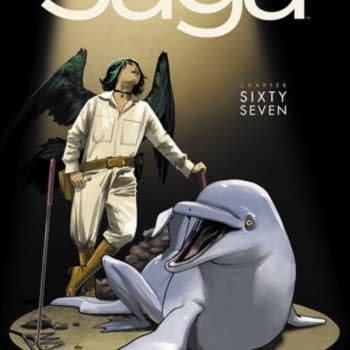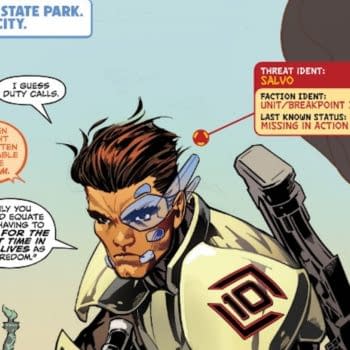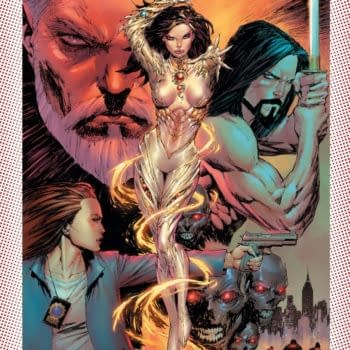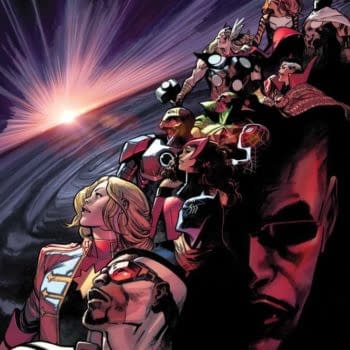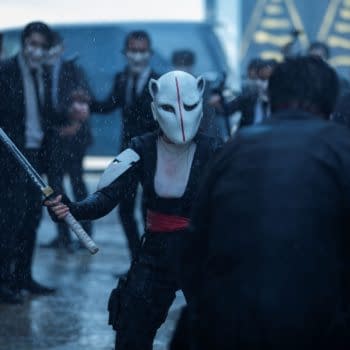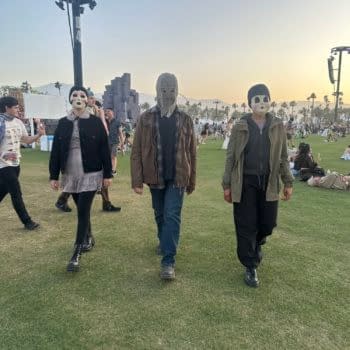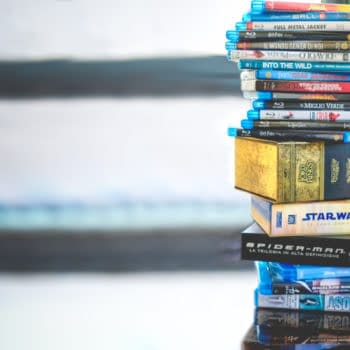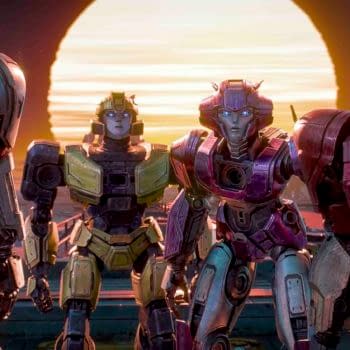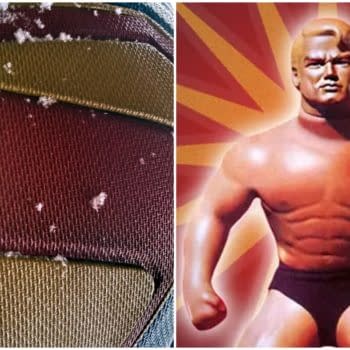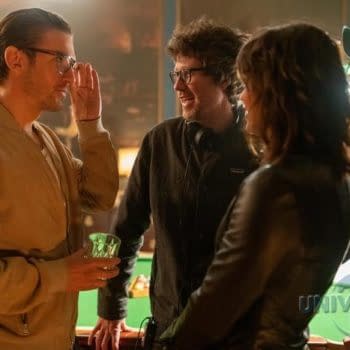Posted in: Movies | Tagged: disney, HRL, nine worlds, queer disney
"A Feeling Of Belonging": Queer Coding In Disney, Part 1, At Nine Worlds
Scholar Avery Delany held a Queer Coding In Disney panel at Nine Worlds in Hammersmith, London, this weekend. Identifying Disney characters who may be intended to LGBTQ+ has become more common, especially in the light of the announcement that Beauty and the Beast would feature its first gay character, but Delany chose to give a greater context to the concept and history of queer coding before diving into the Disney. And had a very specific observation common to their live-action vs. animated versions of movies that I hadn't heard before.
Delany talked about Disney characters given traits associated with queer people, but not identified as such. Avery's first such personal observation of this trope was with Scar in The Lion King, and he also identified Starbuck in Battlestar Galactica and Joe Cairo from Maltese Falcon. He pointed out the trope was usually there for a character to be mocked, pitied, or feared. That it taught straight people what to think about gay people and taught gay people what to think about themselves.

This included men having feminine mannerisms, flamboyancy, lacking interest in women, being conniving or intellectual. Whereas in women, the trope portrays them as often thuggishness and masculinity, and having a lack of interest in men.
He looked at the concept of the "sissy", a character that made men feel more manly, and pointed to an 1895 clip of men dancing together. And the Charlie Chaplin film Behind The Screen, a movie which saw Chaplin kissing a woman dressed as a man, only to be approached by a larger man, who initially looks aggressive, but is instead portrayed with feminine mannerisms. When he touches them on the cheeks, the audience is expected to understand. This kind of behaviour on screen became more and more pronounced in the '20s and '30s and spurred the Hays Code and the Legion Of Decency to act over such portrayals. Queer coding allowed people to use gay characters that they weren't able to otherwise.
There was special concern for animation, with its appeal to children, showing gay characters — though as Delany pointed out, the death of Mufasa or Bambi was apparently fine. But kids like Avery still noticed Scar. He pointed out that Disney wants to portray a feeling of belonging. And growing up as a female, he found strength in princesses as role models. But he also noticed the big cats, rats and snakes of Disney, often cunning, dangerous or vermin, for their coding.
The two biggest examples he gave contrasted with their live-action remakes, and what he sees as the erasure of queer coding from the animated version to the live-action ones.
Watching the live-action Jungle Book, he hated it as a result. He quoted director Jon Favreau's denials of any such messages saying "it's a fantasy about a boy living among both friendly and dangerous animals, and coming of age."
So characters such as Shere Khan, the live-action version was a violent, aggressive "yelly Dumbledore" whose power comes from brute strength. The live-action animation, however, is one that's cunning, intelligent, sassy, making effeminate movements, sadistic, smooth and sophisticated.
He pointed out how Kaa, now played by a woman, Scarlett Johansson, removing the coding completely, and that the original voice, Sterling Holloway, was originally based on '60s stereotypes of older predatory homosexual men for the seduction of young Mowgli.
But he saved his greatest ire for the recreation of Baloo and Bagheera. He showed how in the live-action version, Bill Murray and Ben Kingsley's characters were hardly ever in the same shot. That Baloo and Bagheera were not friends and had no previous relationship, and that they cared for Mowgli separately rather than together. The animated version with Phil Harris, who played a similar role in Aristocats and Sebastian Cabot, saw them as co-parents, Bagheera as the mother and wife, Baloo as carefree dad, running from responsibility, and that they nag and bicker like an old married couple — and even dance together.
And we also got to see the scene of Baloo dressing up as a female ape to dance with King Louie and the infamous line, "Take me home, daddy!"
He also brought up Beauty And The Beast with similar annoyance, even with a film meant to have Disney's first gay character.
Because he pointed to Cogsworth and Lumiere, voiced by David Ogden Stiers and Jerry Orbach in the animation, always shown together, and always touching. While the live-action version of Ewan McGregor and Ian McKellen, spend less time together, with no physical touching, a sense of distance and lack of coding, even with McKellen.
While LeFou, promoted as their first gay character, played by Josh Gad, in the live-action role, there as the sissy to complement Gaston's machismo, comedic relief, was actually not stated as gay, merely dancing with another man — an attempt at open gay coding rather than an out gay character. While the original animated version voiced by Jesse Corti was attracted to women, and wanted to be Gaston rather than wanting to be with him. Avery's allegation was that Disney put the clumsier gay coding in the wrong place.
Delaney also talked about other animated gay coding from Disney with Timba and Poomba in Lion King and Jumba and Pleakey in Lilo and Stitch, both developing as co-parents, Chief Bogo and Clawhauser in Zootopia, together dancing at the end — as well as using queer face apps on their phone. Zootopia was also mentioned for Judy's neighbours, gay married couple, who the director stated didn't argue because they are gay, but because they are real. Though Avery said, "You could have said that in the film, don't be J.K. Rowling..." but it was another example of LeFou being Disney's first openly gay character not being true. "He's not, and he's not even open."
I'm not sure how Delany will react to Chiwetel Ejiofor's upcoming Scar for a live-action Lion King. I'll have to ask him…
Avery acknowledged a lack of queer female coding, saying that while male feminity can be seen as an ultimate transgression, disempowered through ridicule, female masculinity is seen as less threatening and has been co-opted as sexy through a male gaze. He pointed out examples from other media providers, though, from Michonne in The Walking Dead, to Gabrielle from Xena, Princess Bubblegum and Marceline The Vampire Queen from Adventure Time, and…everyone Michelle Rodriguez plays. While in Disney, the women are often princesses, and they have to have their prince.
Avery also talked about trans coding, something less touched on. He dismissed the character of Ursula, even though she was based on a drag queen, because she wasn't trans. But for Avery, Pleakley from Lilo and Stitch read as trans. He included Pleakley in the gay coding section, but points out that Pleakley wears women's clothing a lot and what began as a human disguise, then takes over as the TV series continued. And in one scene where Pleakley is described as not being a woman, Pleakley runs away crying. The conclusion of the episode has the cast concluding that Pleakley's clothing choice didn't matter as long as Pleakley was happy.
Mulan is a film that causes lots of debate as to whether it portrays a trans character trans. Some read Mulan as female, some as trans, as the character adopts a male role for extended period of time, but also develops relationships with other cast members within this presentation — including picking up signals of interest from Captain Shang as a male character.
Avery acknowledged the controversies, saying that coding creates varied and personal interpretations, people's own interpretations, their own perspective and identity, and care should be taken when declaring one interpretation as use as see them equally important in another interpretation. And that characters can be more than one thing, with a fluidity of interpretation giving room for everyone.
As for Part Two? Well, there wasn't really one, at least not officially. Instead, it just continued in the bar…









